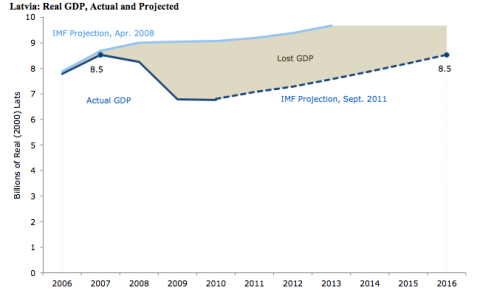Austerity: The Baltic experience

The Baltic experience of front loaded austerity has not been a happy one, contrary to what some commentators would have us believe. By Tom McDonnell.
Irish Times economics editor Dan O'Brien recently argued that the Baltic countries provide good examples of the case for front loading austerity. He notes that: "Estonia’s GDP grew by a blistering 7.6 per cent last year, Latvia’s by 5.5 per cent and Lithuania’s by 5.9 per cent. The three were – by a considerable distance – the fastest growing economies in the developed world." He suggests that front loaded austerity and greater competitiveness - i.e. internal devaluation - are required to resuscitate the economy.
I would argue that this feel-good story needs to be put in context. Unfortunately the recent experience of the Baltic countries has not been a happy one, and these countries grew so fast in 2011 in part because they had previously fallen so very far. Table 1 of this paper by Terazi and Sanel shows the scale of the decline in real GDP in 2009 alone. The Baltic countries suffered the largest declines in economic output in the EU, despite already being amongst the poorest EU states in terms of GDP per capita.
The Latvian experience has been particularly traumatic. This paper from Weisbrot and Ray of the CEPR provides an overview of the Latvian experience. Latvia's loss of output was 24.1% - even larger than Ireland's (see figure 1 for a comparison with historical downturns). The IMF estimates that Latvia's real GDP will only return to 2007 levels in 2016 (see figure 2). Effectively a lost decade, and surely no blueprint for 'best practice' in managing downturns. Weisbrot and Ray argue that the data contradicts the notion that Latvia's experience provides an example of successful internal devaluation, and they caution that weaker Eurozone economies should be wary of becoming locked into pro-cyclical policies.
Unemployment in the three Baltic states also remains above the EU average of 10.2%. Estonia fares best at 11.8%, while Latvian unemployment is 14.6% and Lithuanian unemployment is 14.3%. The employment rate in all three countries is also below the EU average. Even these figures don't tell the full story, as it is estimated that Latvia's net loss of population in 2009-2011 amounts to as much as 10% of the labour force.
Overall the picture is mixed. Estonia has certainly fared better than Latvia and Lithuania. The IMF country report for Estonia is here. Figure 3 on page 23 of the pdf shows the impact on employment since Q3 2007, with net employment still below 2007 levels. GDP still remains below 2007 levels five years on, although Estonian GDP is forecast by the IMF to pass that threshold in 2012 (see table 1 on page 29 of the pdf). {jathumbnailoff}
I guess success is relative.
Latvia's Internal Devaluation - A Success Story?

Originally published on Progressive Economy @ TASC. Republished with permission.
